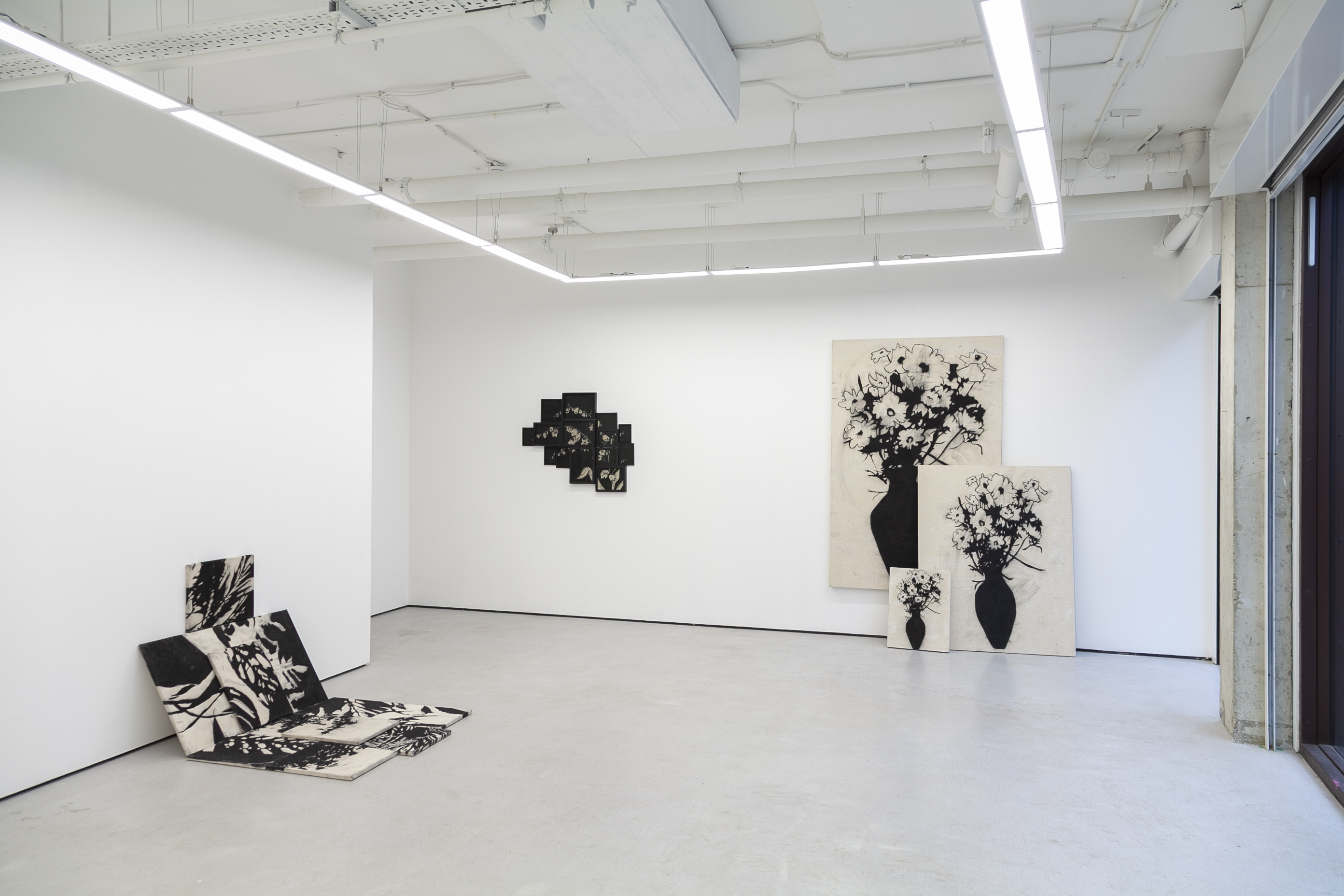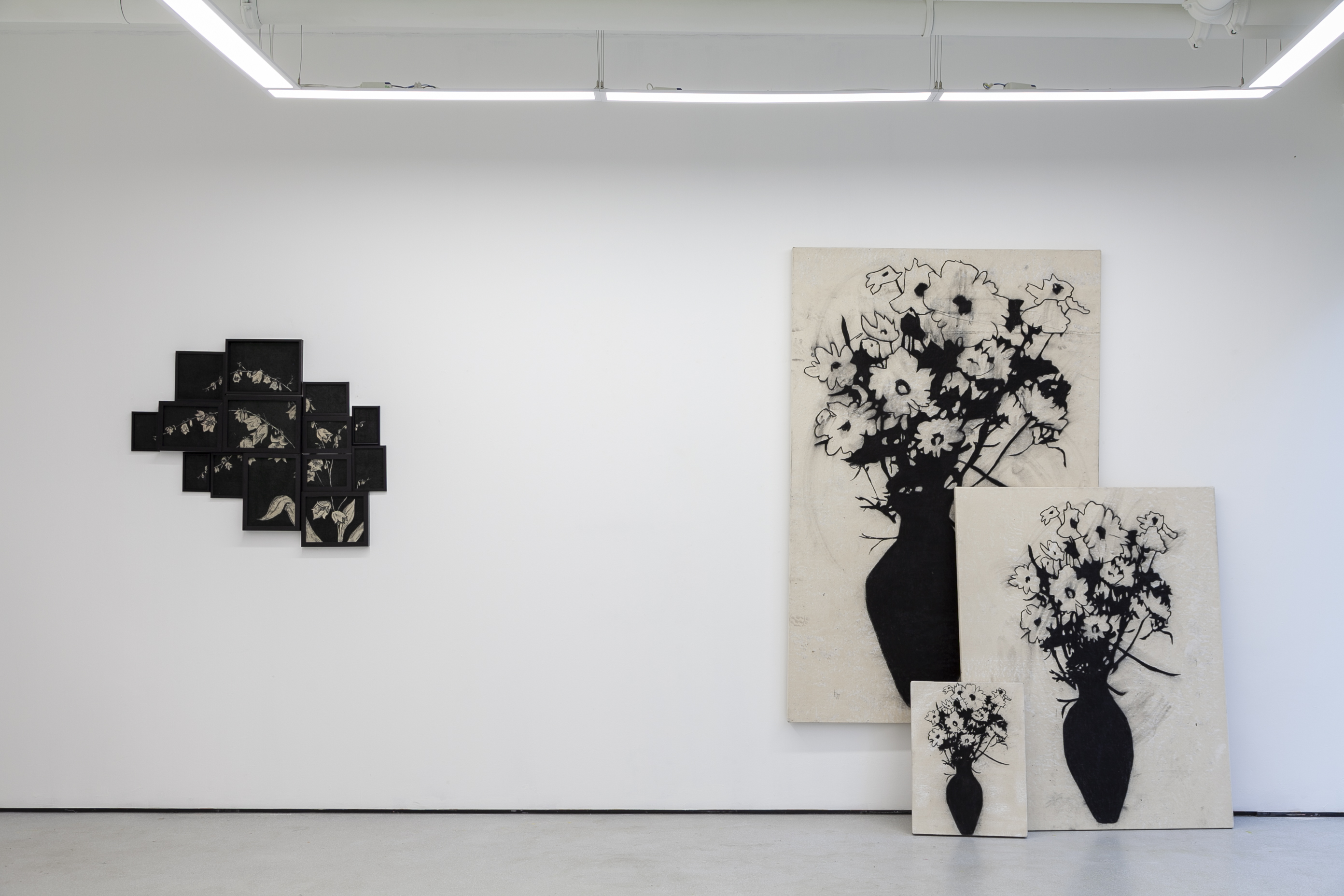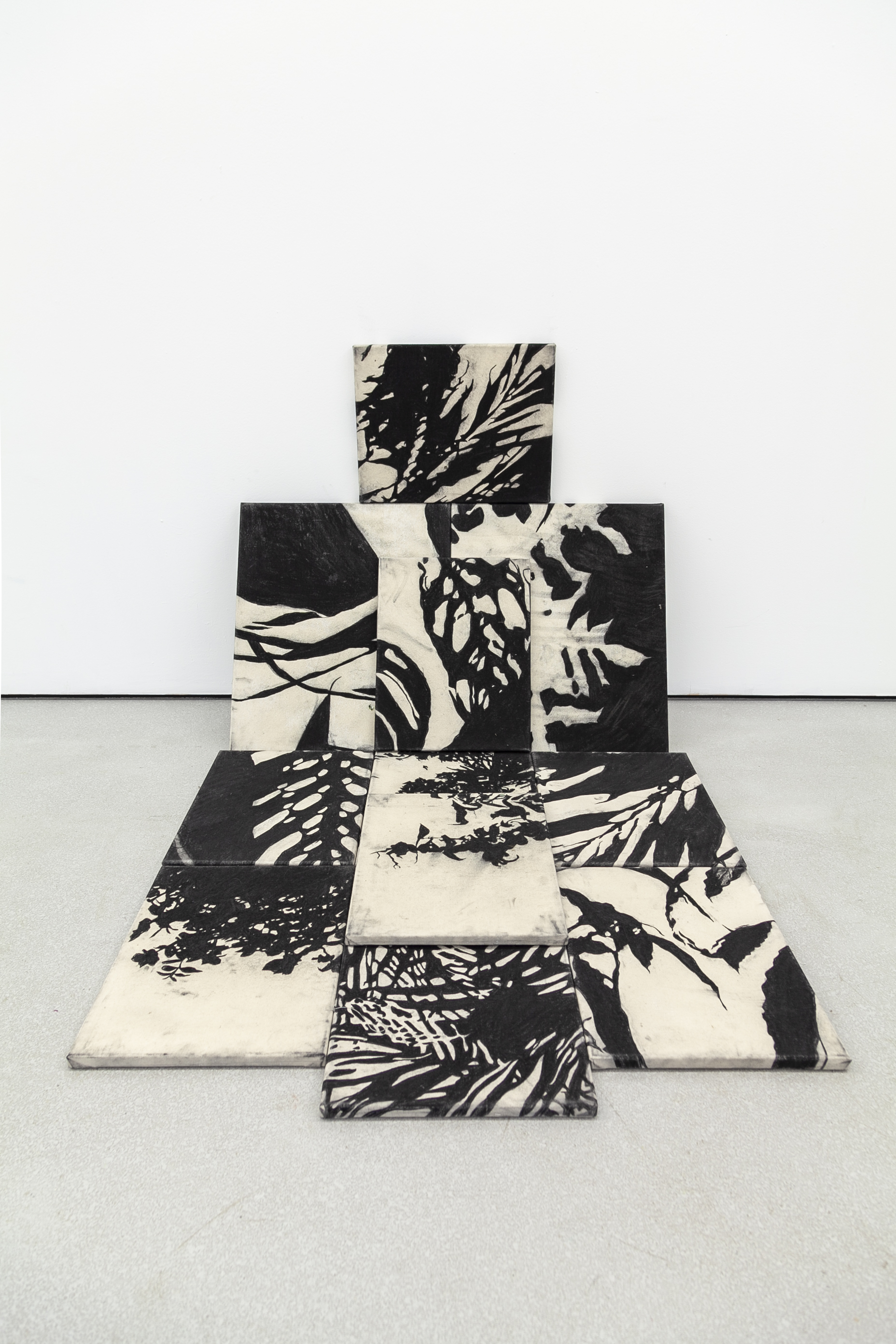Benjamin Murphy
Interview by Hector Campbell
-
Published in January 2022
-
Back in 2019, I was kindly invited to write the exhibition text for Benjamin Murphy’s exhibition ANTIHERO, at this time his sixth solo exhibition, and second to take place in Helsinki. Over the years I’ve also interviewed, and been interviewed by, Benjamin, and have collaborated with him on a number of different projects under a number of different guises. To mark his latest solo exhibition, I travelled to Benjamin’s studio in East Ham to catch up properly after two pandemic-plagued years, to discuss the recent development in his practice and to get a glimpse into the artworks he’s produced for Disasterpiece.
-
 Disasterpiece, Solo Exhibition at Lychee One, 2022
Disasterpiece, Solo Exhibition at Lychee One, 2022I recently read back the text I wrote for ANTIHERO, and found it interesting that I started by stating “ANTIHERO marks a stark departure from what we already know, or think we know, of Benjamin and his work”. That statement of course felt relevant at the time, but perhaps now seems much more apt for this exhibition. Since ANTIHERO, the black electric tape is gone, figuration is gone. The work is still for the most part representational, and your distinct monochromatic, black and white colour palette remains, but it seems as though the last two years have seen significant change in your work and practice?
It’s not even quite two years actually, the first work I made with charcoal would have been in February of 2020
So just pre-pandemic. What triggered that departure and development?
I felt like the previous work I was making had become a little formulaic, and I myself had got a little bit bored with what I was doing at that time. It felt as if I was doing the same thing over and over again, the same actions, and because those tape works took so long to make, I didn't feel like I had the time for any experimentation or play. Often, I would know exactly what I was going to do and where each artwork would end up. I was in a cycle of making artworks for exhibition, not for myself. I started to think that if I didn’t love what I was doing, what was the point of doing it at all.
Then, while talking to my students [Benjamin lectures on an MA Illustration and Visual Media course] they would tell me all their crazy ideas and have the freedom to just go off and do them. I wished for that same freedom, to be able to conceive of an idea and then enact it right away.

Disasterpiece, Solo Exhibition at Lychee One, 2022
Had you started to feel pigeonholed in a way, as the ‘tape guy’? Obviously, you had much success with that medium, and had been pursuing it for many years through six solo exhibitions.
I did slightly, I felt I had to make a certain type of work, that was what was expected of me and that was what galleries expected of me. But I had planned to take 2020 as a year off from exhibiting anyway, so I was less worried about the shows drying up, or the sales drying up. At least I would be loving what I was doing again, and enjoying that freedom I saw my students enjoying.
I resigned myself to making bad work for a while. I decided to be in the studio making, with no plan for where it was going. I discovered charcoal, something I really enjoyed and that felt different, fairly quickly. As working with tape was always so precise, so clean and intricately detailed, I knew I instead wanted a medium that was dirty and messy, that I didn’t immediately understand. I started painting a little, and then found charcoal. I could instantly achieve tone like I never could with tape, and I could still get the really deep black that I wanted. Then I started using charcoal on raw canvas, and enjoyed how inflexible it was. If I got a smudge on there I can’t erase it and I can’t paint it out, because it’s unprimed.
In that way, it's quite an unforgiving medium and material.
Exactly. And I wanted to record every gesture. Sometimes I place canvases on the floor and leave them for a while, or I leave the unstretched canvas lying around before I’ve even begun working on it, because I want to pick up the dirt, to celebrate that dirt.
You can see the result of that, with some of these larger works you can find footprints on the surface, they have those remnants of being in the studio, proof of their production.
For sure, and with this subject matter, a lot of plants, a lot of shadows, I want them to be a little disordered and chaotic. So, I think that in the way that I’m making these works, by allowing for certain marks or dirt to firm, all of that becomes important. It’s partly the subject matter, partly the medium. I’m allowing the disorder of the studio to find its way into the work.

Disasterpiece, Solo Exhibition at Lychee One, 2022
When you started to develop these new works, with this new way of making, it must have felt scary to start with, like you were taking a big risk?
When it came to it, it didn’t at all, it felt freeing. But definitely before that point, I had wanted to make a change for a long time, and hadn’t out of hesitancy or nervousness. I had felt constrained by consistency for some time.
Of course, one thing that remains consistent is the colour palette. It’s still to a large extent black and white, monochromatic, with some greyscale. Was that consistency a conscious decision? Did you experiment with colour at all during that period of change?
I didn’t experiment with colour. For me, the use of black and white is more out of necessity than a conscious choice really. I don’t understand colour, I never have, and I have no interest in it. My mind simply articulates itself in black and white.
And then I guess you can show gradation through shadow and tone.
I can now, I didn’t used to be able to. Also accidental shadow I really like, just through the grime of the charcoal. I prime the canvases for rigidity, but on the back using firstly a really thin layer of very watery gesso, and then a thicker layer on top of that. When priming with a thin coat, it seeps through in patches and adds an uncontrollable nature to the work. It also picks up a lot of that dirt from the ground, which I really like.
I guess the final major change would be the subject matter. For a long time, your work was mostly figurative, with occasional floral elements entering into the larger more interior or domestic compositions. Was that a deliberate choice you took, or a result of finding this new interest and medium in charcoal?
That was a conscious choice definitely. As I mentioned, I wanted to experiment and play, and when drawing the human figure you have to be quite meticulous. When drawing a face for example, and one eye is an inch too far to the left, it looks ridiculous. That’s not the case with plants. If something is in the wrong place, it doesn’t matter as much. I wanted to give myself as much freedom as possible, to make works quickly and subconsciously, without having to plan or sketch, and plants or flowers are perfect for that.
So now you have a combination of quite an unforgiving medium, as we’ve discussed, but a more forgiving subject matter. You can work faster, make mistakes, and those mistakes will be permanent, but just like with the dust and grime from the studio, those mistakes can be incorporated into the final work. So are you working from life, from photos, or purely from your imagination at this point?
I do take a lot of photos of shadows and plants, I work from found imagery, I work from sketches sometimes. But often when it comes to making the actual work I just freestyle in parts, so it’s often quite far removed from that original reference material.

Disasterpiece, Solo Exhibition at Lychee One, 2022
So in terms of the plants that we’re seeing, they’re real flowers, real plant species. Fact, not fiction, as it were.
Most of them, yes. It becomes a combination really, some are based closer to photographs or source imagery, some are more experimental.
Let’s talk about Helsinki, I know you spend a lot of time out there. Have you worked out in Helsinki? Do you maintain a studio over there?
I live between here and Helsinki now. Especially because of Covid, I spend about a third of the year out there. I spent the first lockdown entirely there. Some of these works were actually made in a basement in Helsinki in minus thirty degree Finish winter, where the snow was shoulder high. The rest of these works were made here in London.
Do you think spending time in Helsinki has had an influence on the work and on your practice? Being surrounded by more nature than you're used to perhaps?
Potentially, yes. A lot of my inspiration, not necessarily in terms of imagery but more for the feel of the work, comes from literature, from things I have been reading. With the previous work I was reading a lot of French naturalism, very elaborate over the top writing, and I think that’s evident. But living in Finland, which is similar to Russia in terms of landscape, and reading a lot of Russian literature, Tolstoy or Dostoevsky, it’s much darker, more morose or melancholic. I think that fed into the work.

Disasterpiece, Solo Exhibition at Lychee One, 2022
That more raw emotion is evident, darkness definitely. As mentioned, your work has always been black and white, but that didn’t necessarily convey darkness quite like it does now. Maybe that’s also the charcoal addition I guess, with that depth of black and the energy and expression captured in the mark-making.
I hope they feel more like they’ve had a human touch, if that makes sense. I wanted that hand of the artist to be present in the work. In the previous work it almost looked laser-cut sometimes, so I wanted these to have those handprints and evident mark making.
We are currently surrounded by many of the artworks for the show, laid out how you intend to exhibit them in these much more inventive and experimentational displays. Paintings are laid up against the wall or flat on the floor, stacked on top of one another and arranged in modular constructions. It seems like the final look of the exhibition as a whole will be a reflection of the studio as well?
Probably, yes. I like to play around a lot with arrangements, installations and layouts. I think rarely is the best way to see an artwork just hung at eye level on a wall. Sometimes that’s the perfect way to look at an artwork, but not always.
Is that something you have learned from also being a gallerist perhaps?
Being a gallerist and being an artist are very connected for me. Whenever you display an artwork, it’s important to think about how it is going to be encountered. If an artwork is hung on a wall at a standard eye-line, the wall itself is not considered, the floor is ignored. You should think about every angle from which someone will view that artwork. I also consider how someone looks from one artwork to another, and how an artwork will be seen within the context of an exhibition as a whole. I think an exhibition can be greater than the sum of its parts, if considered as an immersive artwork in it’s own right
Do you think this more experimental, experiential viewing model lends itself more to the kind of artworks you’re now making? A little looser, a little messier, a little bit more emotive.
Both my subject matter and my approach to making focuses on that which is often overlooked, or what is sometimes in the shadows. So placing a work on the floor, or hanging works right in the corner of a gallery, maybe accentuates that slightly.

Disasterpiece, Solo Exhibition at Lychee One, 2022
So do these display decisions happen before or after the making of the work? For example, these multi-paneled pieces that form one complete work. They feel like crops of larger compositions or details from larger un-made works?
It happens afterward. I make the panels individually, and then they can become modular and can take on different forms. They are all still depictions of shadows or plants, only cropped to the point at which the representation almost looks abstract. Then the way I combine them can codify and further abstract them from that original representation. These modular works can respond to the exhibition around them or how I’m feeling in each gallery space.
So they have a certain degree of site-specificity to them. If you were to exhibit the same modular construction in another space at another time, that layout might change?
I would like to experiment with that definitely, to reconfigure them for future exhibitions. Also, were I to sell one of these modular works, I wouldn’t dictate how it was eventually displayed, as long as it was kept together.

Disasterpiece, Solo Exhibition at Lychee One, 2022
They become ever-changing puzzles, with no correct formation. I like that you wouldn’t dictate how a collector was to display it!
I’ve been sent photos of my artwork hung on lime green walls in collector’s homes before, and it looks terrible! But if that’s how they want to display it, I can’t change that, it’s out of my control.
-
benjaminmurphy.info
hector-campbell.com
-
If you like this why not read our interview with Betsy Bradley.
-
© YAC | Young Artists in Conversation ALL RIGHTS RESERVED
